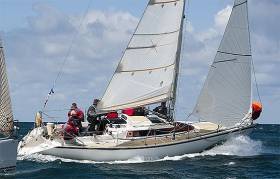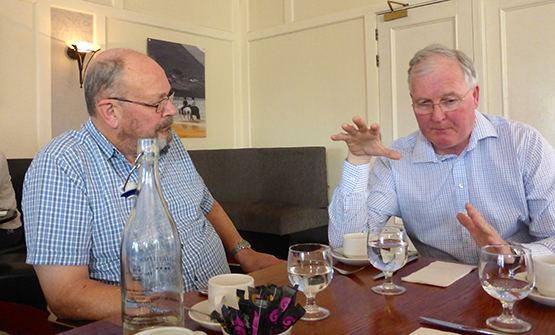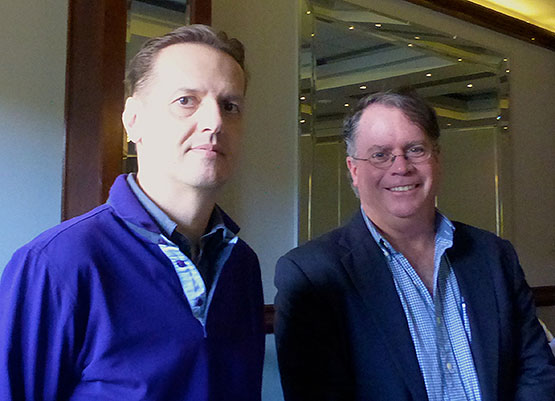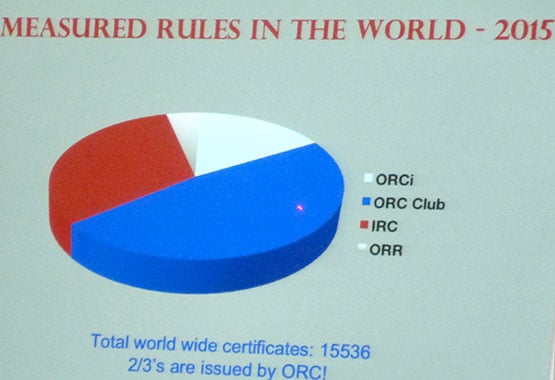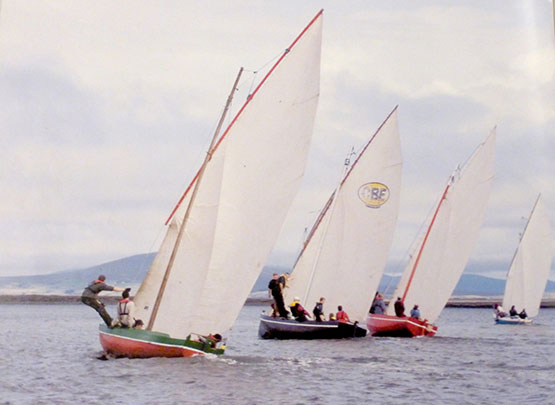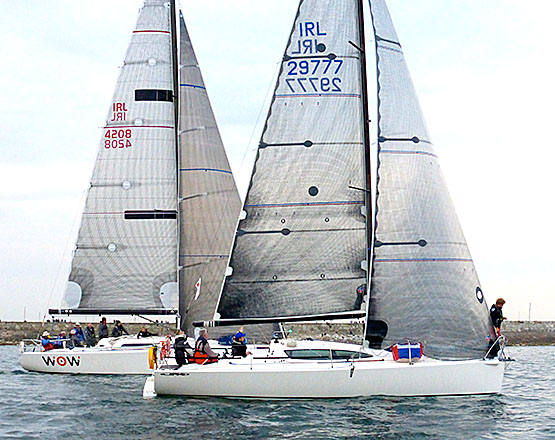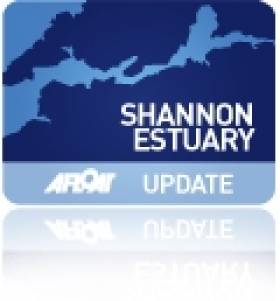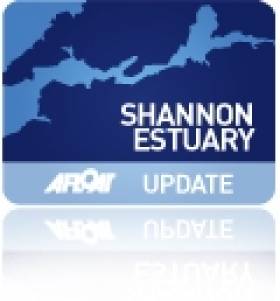Displaying items by tag: Foynes YC
Show of Youth Sailing Strength for Royal St. George As Big Breeze Forecast for Junior All–Irelands
Tomorrow's All Ireland Junior sailing championships looks like it will get off to a wet and windy start for the 16–nominated junior sailing stars drawn from seven yacht clubs from around the country.
The Under–18 championships is scheduled to race over two days in West Cork's own TR3.6 two handed dinghies but the weather forecast for the Schull venue shows winds topping 40–knots for Saturday and the same again on Sunday.
 XC weather forecaster shows big winds in Schull, West Cork tomorrow
XC weather forecaster shows big winds in Schull, West Cork tomorrow
In a show of strength for Dublin's Royal St. George Yacht Club more than a third of the participants are drawn from the Dun Laoghaire club. RStGYC juniors are representing the RS200 (Toby Hudson Fowler), the RS Feva (Henry Start), Laser 4.7 (Peter Fagan), Optimist (Tom Higgins), Topper (Jack Fahy) and Kate Lyttle from the 420 class.
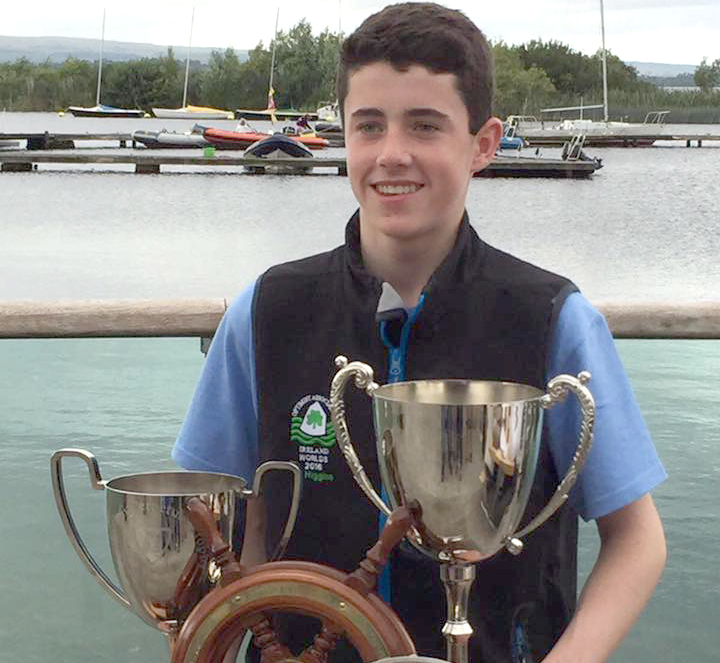 Multi–champion in the Optimist class, Tom Higgins from the Royal St. George, is nominated for this weekend's All Ireland Juniors in Schull
Multi–champion in the Optimist class, Tom Higgins from the Royal St. George, is nominated for this weekend's All Ireland Juniors in Schull
Royal Cork Yacht Club is the next biggest club on the water in Schull with four sailors involved. 29er skipper Harry Durcan and twin Johnny representing 29er and Laser Radials respectively. Harry Twomey represents the Optimist class and Sophie Crosby sails for the Toppers.
The National Yacht Club's Clare Gorman represents the Laser 4.7 and will defend the girls title and the NYC's Leah Rickard sails for the Optimists.
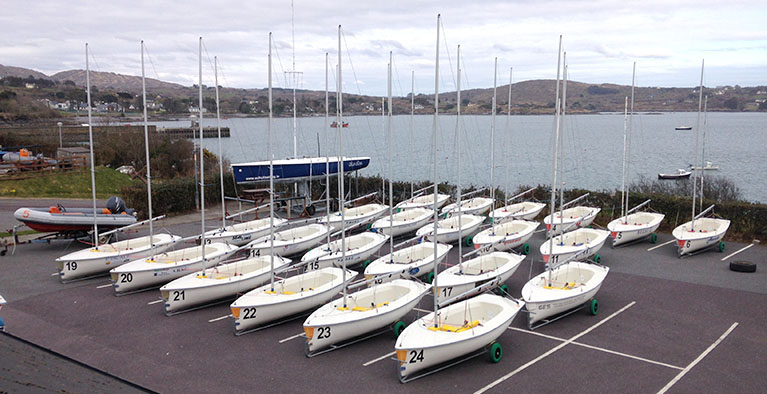 Schull's own TR3.6 dinghies ready for the junior all Ireland sailors. Photo: Fastnet Marine
Schull's own TR3.6 dinghies ready for the junior all Ireland sailors. Photo: Fastnet Marine
The West coast is represented by three clubs.Topaz sailors Adam Byrne and Dylan Reidy representing Dingle SC and Foynes YC respectively and Sligo Yacht Club sends Mirror ace Sarah White.
The 420 class is represented by Geoff Power of Waterford Harbour Sailing Club.
Full nominee list below
| Class | Name | Surname | Club |
|---|---|---|---|
| RS200 Junior | Toby | Hudson Fowler | Royal StGeorge YC |
| RS Feva | Henry | Start | Royal St George YC |
| Mirror | Sarah | White | Sligo YC |
| Laser 4.7 | Clare | Gorman | NYC |
| Laser 4.7 | Peter | Fagan | Royal St George YC |
| Laser Radial | Johnny | Durcan | RCYC/NYC |
| Topaz | Adam | Byrne | Dingle SC |
| Topaz | Dylan | Reidy | Foynes YC |
| Topper | Jack | Fahy | RSTGYC |
| Topper | Sophie | Crosby | RCYC |
| 420 | Geoff | Power | WHSC |
| 420 | Kate | Lyttle | RStGYC |
| OPTIMIST | Tom | Higgins | RSGYC |
| OPTIMIST | Harry | Twomey | RCYC&CHSC |
| OPTIMIST | Leah | Rickard | NYC |
| 29er | Harry | Durcan | RCYC |
The Irish Cruiser-Racer Association (ICRA) is a unique organisation. “Run by sailors for sailors”, it is nevertheless a very land-centric administrative body whose only manifestation afloat as a group with its own identity is seen at the organisation of the annual ICRA Nationals. And the sense of it relating purely to the island of Ireland is accentuated by the fact that much of its work is essentially back-office activity, dealing with handicaps and all the other paraphernalia involved in providing the nation’s numerous and very diverse cruiser-racer fleet with meaningful racing. W M Nixon went to last Saturday’s ICRA Conference to get a flavour of what ICRA does, and came away both impressed and stimulated.
Sweeping along southwestward towards Limerick on our wonderful motorway system, while one’s body stays firmly on the dual carriageway, the mind can wander into any pathways it wishes. So we got to thinking that, in this age of increasing numbers of administrators trained to third level degrees in the running of not-for-profit organisations, it’s a bit odd to find a very successfully central organisation which is apparently run – and well run at that - on a Corinthian basis “by sailors for sailors”.
Surely in today’s climate, which favours key bodies such as this being run by highly-trained specialists on at least a semi-professional basis, a seemingly amorphous organisation which is “run by sailors for sailors” is verging on a clear case of the asylum being taken over by the lunatics?
We’d soon see. Meanwhile, why on earth hold an annual conference in Limerick? With Ireland’s population distribution changing so rapidly, skewing both towards the large urban centres and particularly towards the east coast and Dublin, surely anyone organising a national conference would find it attendee-friendly to look at the latest map of population weighting. As it happens, I’m not sure that such a map exists, but we’d like to think that with today’s computers it is possible to construct a map where, after due calculation, you could pinpoint to the exact centre of Ireland’s total population distribution.
So you set out heading for Limerick at an unfeasibly early hour thinking that maybe a central location such as pretty Portlaoise or tidy Trim would probably be Ireland’s central point in relation to population distribution. But after some smooth time on the road with the sense of the wonderful west coast coming ever nearer, you begin to wonder why ICRA didn’t make a proper job of it, and take us to Dingle where we can breathe that wonderful Atlantic air and think great thoughts of sailing the high seas.

Far from the pressures of the cities of the east and south coasts, Dis-a-Ray is moored in the peaceful surroundings of Tarbert, where the south shore of the Shannon Estuary has already become part of the Kingdom of Kerry. Photo: W M Nixon
As it is, though the Dubs may think of Limerick as being on the western seaboard, it’s actually remarkably central when you draw lines across Ireland between all the best sailing locations. And as we knew that the position of Commodore of ICRA was going to pass on Saturday from Nobby Reilly of Howth (the Dingle of the East Coast) to Simon McGibney, Limerick was just about spot on in terms of equal travel time. For although the new Commodore has Foynes YC on the Shannon Estuary as his home club, his Dehler 101 Dis-a-ray is actually moored at his home at Tarbert which is further west down the Estuary, so much so that Tarbert is in the Kingdom of Kerry.
We arrived in to find a virtually full house distributed around a room-circling table such as they use for international diplomatic conferences to make peace with rogue states, with the layout being planned so that everyone can be an equal participant. It was grand for those of us who had arrived in the nick of time to get a seat, as we’d the fully-equipped table in front of us (did anybody else find it the devil’s own job to open the rather good but tightly-wrapped little sucky sweets which are essential to a talking shop?), but being Ireland several people arrived late, the show was already on the road, and they’d to find a seat as best they could.
All of which meant that there was a bigger turnout than expected, which is good news for ICRA. And for those of us comfortably ensconced, it made for a fascinating throughput of information by a long list of speakers, even though the layout meant that networking was restricted to the one hour lunch break if - like many people - you were relying on the 3.30-3.45pm wrap-up to facilitate returning to Dublin or Cork or wherever for a completely different event that night.
From the beginning, the dominant theme was on how we get more people into sailing, and everyone blithely talked as though we’re offering Joe Public a warm and sunny Croatian sailing product right here in Ireland, cheerfully ignoring the fact the last two summers have been plain lousy in terms of good weather.
Certainly the sailing was great for the enthusiast, but can you imagine a newcomer to the rough and ready sailing world wondering where on earth the attraction of it all was to be found as they were blown and bashed around at what we thought of as the utterly wonderful ICRA Nationals at Kinsale in June, or took in the all-too-typical variety of Irish summer weather at the hugely successful Volvo Dun Laoghaire Regatta in Dublin Bay in July?
Yet there is a fresh demand out there, and two of the morning’s speakers, Alistair Rumball of the Irish National Sailing School in Dun Laoghaire and Des McWilliam of McWilliam Sailmakers in Crosshaven, gave excellent talks on encouraging it, with Alistair showing us how his programme of moving beginners through dinghies and on into the school/club’s1720s, then became an inevitable progression into gaining experience and instruction on the school’s Prima 38 Lynx.
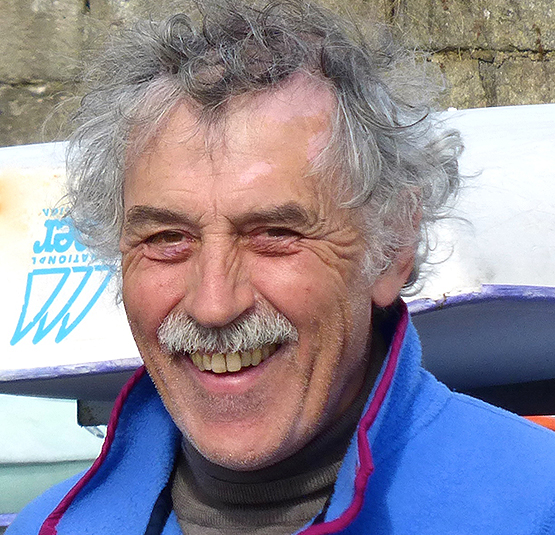 The mover and shaker. Alistair Rumball’s Irish National Sailing School in Dun Laoghaire is first port of call for many newcomers to sailing. Photo: W M Nixon
The mover and shaker. Alistair Rumball’s Irish National Sailing School in Dun Laoghaire is first port of call for many newcomers to sailing. Photo: W M Nixon
“Lynx has been a greater success than we could have ever dreamed of” he said. “She has been so booked out with people keen to learn about sailing a cruiser-racer that we haven’t been able to get as much actual racing with ISORA and so forth as we’d like. But for 2016, she’s being taken out of our Dun Laoghaire setup for long enough to be organised for a proper shot at the Volvo Round Ireland”.
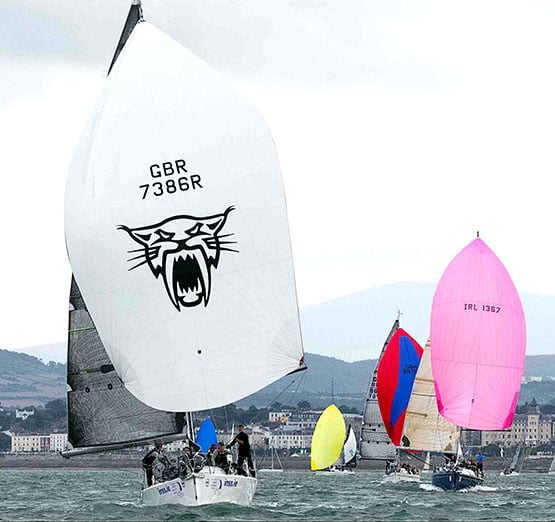
The double life of a Prima 38. The INSS’s Lynx in full racing mode in Dublin Bay (above), while below she is seen in early training mode as she takes a crew of beginners in cruiser-racing out for some formative experiences

As of last weekend in Limerick, there were just two crew places left aboard Lynx for this year’s Volvo Round Ireland on June 18th, and they’ve probably been snapped up by now. But the Rumball presentation underlined the fact that there are people out there who are mad keen to get into cruiser-racing, and it was up to ICRA to guide its members as to how best to tap into these wannabee sailors, instead of bleating all the time about how hard it is to find crew.
Des McWilliam leapt into the same theme, and gave us a crash course in how to make crewing on your boat more attractive to strangers. Admittedly the experience of seven years of acute economic recession have understandably made those who have kept boats in racing commission more than a little stressed. But if they want to reap the benefits of having struggled to stay in the boat-owning stream, then they have to make their cruiser-racers pleasanter to sail on, and more effective racing machines.
The McWilliam message was blunt in the extreme. “As a sailmaker in Ireland, each year I will race actively at many venues on upwards of 40 boats, both evenings and weekends. I will experience many different management and sailing styles. At the end of the year looking back, I usually realise that there might be only ten to a dozen boats out of that total of forty to which I would gladly and freely return for the good sport, the efficient sailing, the successful racing, the camaraderie – the fun. The rest of them are just work, involving duty visits. Please remember this when you are setting up the running of your boat, and trying to encourage people to sail with you.”
Des McWilliam of Crosshaven and Rory Staunton of Mayo. Des provided the meeting with some telling home truths about how attractive (or not) cruiser-racers throughout Ireland can be to sail on, while Rory Staunton led the charge in wondering why ORC and IRC cannot be amalgamated, and then went on to outline a new trailerable 33-footer he and an international group of friends are developing to make the incomparable west of Ireland a more accessible sailing area
We earned our lunch by going through an intensive session with Dobbs Davis of the Offshore Racing Congress, who had come to the conference with Zoran Grubisa to promote their measurement rule, which is used worldwide anywhere that IRC is not dominant, and in some key events such as the Rolex Sydney-Hobart Race, they are used in tandem, though IRC is currently the more-used system in that classic event.
It says everything about how Irish sailing punches way above its weight that these two guys thought it worth their while to come among us and evangelise for their system in a country which has a more-than-friendly relationship with the IRC and the people who run it. But it was fascinating stuff, making an input which added real spice to the day.
Davis is Chairman of the ORC’s Promotion & Development Committee, while Grubisa heads the Rating Officers Committee, and they run a system which is now the ISAF-approved rating method for the ISAF Offshore Worlds, which this year will be staged in Copenhagen in July, which as it happens is more or less the same time as the Royal Cork YC will be staging the new European IRC Championship in Volvo Cork Week at Crosshaven.
So the presence of the evangelists from the ORC at the ICRA conference could have opened up a right can of worms, but fair play to Dobbs Davis, he gave such an enthusiastic and lucid explanation of the completely transparent way in which ORC function that, for the time being at least, one’s instinctive loyalty to IRC was suspended out of intellectual curiosity.
Leading Offshore Racing Congress officers Zoran Grubisa (left) and Dobbs Davis were in Limerick to evangelise for the ORC Rating system
While IRC still has one or two hidden elements – the “Black Box” factor – with the transparency of ORC, you can always see how different inputs are effecting the final figure. One-design sailors may find all this utterly yawn-making, but as Davis pointed out, although there are so many successful cruiser-racer One-Design classes in America that ORC has yet to gain significant traction there despite being first set up in the US forty years ago, elsewhere in the world more and more people are coming to ORC as they enjoy watching boat innovation and performance analysis interacting to make their sailing more interesting and the results indicative of pure sailing ability.
The approachability of the ORC system was presented as one of its advantages
The slice of the cake worldwide for the different rating systems
But as we all know, where IRC and OCR are run side-by-side, despite the IRC’s hidden elements the two outcomes are often very similar. And in Ireland where we have a soft spot for the old S&3 34s which set world alight in 1969-73, the fact that the veteran though beautifully restored S&S 34 Quikpoint Azzura was overall winner of the Rolex-Sydney Hobart Race under OCR, after so nearly doing it on IRC, caused a bit of heart-searching. But nevertheless Rory Staunton from Mayo SC spoke for many when he demanded to know why IRC and ORC couldn’t get together and resolve their small differences for the general benefit of the offshore racing fraternity. Dobbs Davis said his door was always open, but that began to feel a bit too reminiscent of the current efforts to form a government, so we were glad enough to take a break for lunch and then return to the rating topic, but from an entirely different point of view
The inevitable expense in maximizing your boat’s performance potential under either IRC or ORC made the sheer economy of ICRA’s Progressive ECHO system seem immediately attractive, and the lead-in the afternoon session by SCORA Commodore Ronan Enright even more apposite. Because the fact is, you could run the Progressive ECHO Handicap System without even knowing what a boat looks like, let alone having her dimensions measured do the last millimtre.
Donal O’Sullivan of Dublin Bay SC, and Ronan Enright, Commodore SCORA, discussing sailing administration matters during the lunch break at Limerick. Enright went on to give an illuminating presentation about developments in Progressive ECHO Photo: W M Nixon
In the absence of ICRA’s ECHO supremo Denis Kiely - unavoidably absent for family reasons – Ronan Enright gave a quietly telling performance. It’s fascinating that though ECHO started life as the East Coast Handicap Organisation back around 1971-72, it’s now a nationwide service overseen by ICRA, and its most active area of development is in the cauldron of concentrated cruiser-racing which you find when the activities of Cork Habour and Kinsale are combined.
Basically, Progressive ECHO depends on the results of the most recent race, after which, if certain criteria have been fulfilled, the results are automatically re-computed to give boats a new rating based the supposition that they had all finished dead level on handicapped time. My own most recent experience of racing with it when it is being enthusiastically applied was in the Volvo Dun Laoghaire Regatta, which was a perfect test-bed for the system, as it was a compact series with the same fleet throughout.
The result is a series-long level of commitment by boats and crews who, under a more brutal system, would have seen their interest and enthusiasm flag after Day Two or even earlier. So really the message is: If we’re trying to get people to enjoy sailing and particularly to enjoy racing which is what the non-involved most easily comprehend, then Progressive ECHO is doing more to get bums on boats than anything else in Irish sailing, for believe me you have never seen anything quite so heart-warming as the response of a crew who, under One-Design or fixed handicap systems, had not been at the races at all, yet suddenly under Progressive ECHO they find they’ve recorded a win.
Which was all good news but perhaps the most interesting revelation of all from Ronan Enright was that the top IRC racers around Cork are now taking a closer interest in their Progressive ECHO showing than there are in their IRC results. For under IRC, they know they’ll be in the top six, but each post-race adjustment of Progressive ECHO gives them a very clear message about just how well or not they were really doing on the day.
Tom MacSweeney of this parish then hosted a forum which basically came down to how sailing can present a more friendly and accessible response to people who might be vaguely interested, and could be potential sailing enthusiasts. This involved him drawing on his training as a critical journalist, for as he admitted, when he first turned up with his first sailing boat – a Ruffian 23 – in Crosshaven, everyone from Denis Doyle downwards immediately made him welcome. But we can all think of non-assertive characters who are great sailors, yet if they hadn’t been in sailing families in the first place, they might not have taken up the sport at all owing to the sometime apparently closed nature of “yachting”.
We learned that very little of an Achill yawl is showing above the water after she capsizes. This is how they look in proper order
Allied to Des McWilliam’s incisive look at boats which you like to be aboard, and boats which you definitely don’t, and it all provided food for thought, as too did John Leech of Irish Water Safety with his no-nonsense presentation about a mature approach both to safety, and to being rescued. In an interesting mix of images, he showed us a photo of what happens to an Achill yawl when it capsizes. The result is an awful lot of rather waterlogged traditional boat under the surface, and only a little bit showing with the crew perched on top. As Des McWilliam was probably the only other person present with any idea of what an Schill yawl in full health looks like, the least we can do here is show you a photo of them in good sailing order. Meanwhile, John Leech concluded by saying that when you call out the ASR helicopters, think rather of how you can prevent your mast – if it’s still standing – from interfering with the rescue. Don’t for heaven’s sake use up emotional energy thinking about how much it all costs. They’re on standby all the time, and you the taxpayer have paid for them in the first place.
We concluded with Rory Staunton seeking interest and opinions for the new 33ft trailerable One-Design. While we all hope to get down to Clew Bay to sail the prototype this summer, could I suggest that one of the most exciting projects on the Irish cruiser-racer horizon is WIORA Week 2017 in the Aran Islands. So when they’ve finally got around to fixing a date, maybe the promoters of the new 33-footers could arrange to have a flotilla of them in Kilronan in 2017 to give the class a rocket-assisted launching.
Meanwhile this year’s WIORA West Coast Championship is under the auspices of the Royal Western of Ireland Yacht Club at Kilrush from June 29th to July 2nd. There’s so much extraordinary history in being able to write that simple bit of information that I reckon we’ll have to give it a complete blog in the future.
As for the ICRA Nationals, they’re at Howth from June 10th to 12th with both IRC and Progressive ECHO being used, while Volvo Cork Week comes up in July after the Volvo Round Ireland race has been tidied away in late June.
Although last Saturday’s Limerick gathering was essentially a wide-ranging conference, it was also the changeover to the new Commodore, with Simon McGibney taking on the mantle from the energetic and enthusiastic Nobby Reilly whose own boat, the Mills 36 Crazy Horse, was seen in virtually every event, and looked like heading for the win in Class at the ICRA Nats in Kinsale last June until new big winds swept George Sisk’s WOW to the fore. During Nobby’s busy time in the top office, ICRA’s activities and its reach steadily expand, while thanks to the persuasive efforts of Anthony O’Leary, a Commodore’s Cup team was assembled which regained the trophy in 2014.
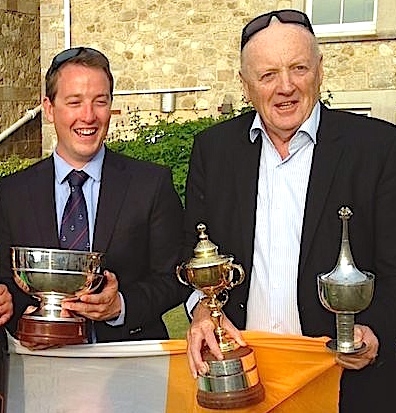 Ross MacDonald and ICRA Commodore Nobby Reilly at the Royal Yacht Squadron in Cowes in July 2014 after Ireland had won the Commodore’s Cup. At the ICRA Conference in Limerick last weekend, McDonald won a special award for his season’s results in 2015 with his X332 Equinox, while Nobby Reilly stood down after his successful years as Commodore, handing over the helm to Simon McGibney.
Ross MacDonald and ICRA Commodore Nobby Reilly at the Royal Yacht Squadron in Cowes in July 2014 after Ireland had won the Commodore’s Cup. At the ICRA Conference in Limerick last weekend, McDonald won a special award for his season’s results in 2015 with his X332 Equinox, while Nobby Reilly stood down after his successful years as Commodore, handing over the helm to Simon McGibney.
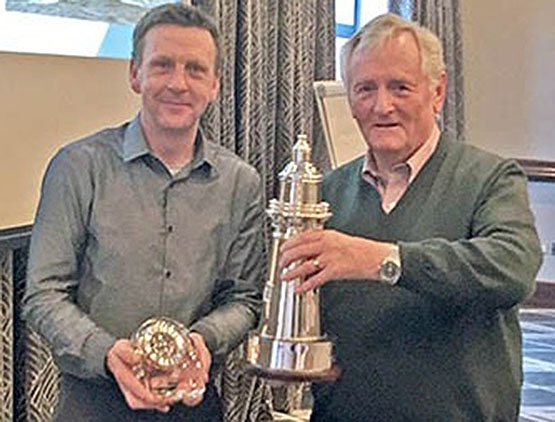
New ICRA Commodore Simom McGibney presents the “Boat of the Year” trophy to George Sisk of the Royal Irish Yacht Club, skipper of the Farr 42 WOW.
Work is going on behind the scenes to provide a strong defence this summer, but Anthony O’Leary wasn’t in Limerick to tell us about it, as he was away on his annual participation in America in the Viper 640 Championship, which just wouldn’t be the same if O’Leary wasn’t taking part - so much so that last year, he wasn’t present when his name came up as “Sailor of the Year” in Dublin, for he was away then too, Viper racing in the sun.
But other top sailors were there to round out the conference with the annual awards such as special performances by the likes of Dave Cullen with Checkmate XV and Ross Macdonald with Equinox and, while the ICRA Boat of the Year presentation, with warm acclamation, went to George Sisk of WOW, who not only admitted that his well-tested craft usually races with a crew of average age 53, but if he himself didn’t happen to be on board, the average age came down considerably………..And in case you think becoming ICRA Boat of the Year is all about glamour racing in sunshine, we close with a photo of WOW and the JPK 950 Alchimiste crawling towards the starting line for the Dun Laoghaire to Dingke race on the sort of damply windless evening that most folk would much prefer to spend comfortably at home.
It isn’t always glamour and warm sunshine and pleasant breezes. 2015 ICRA Boat of the Year WOW on a damp and windless evening approaching the start of the 280-mile Dun Laoghaire to Dingle race with the JPK 960 Alchimiste.
Foynes Yachts Take Line Honours in Cappa Race
#foynes – The last long race of the Foynes Yacht Club season took place last Sunday to the Clare coastal village of Cappa for members of Foynes Yacht Club writes Gerry Ryan.
The Officer of the Day, Ger Reidy sent the fleet from Cooleen Point racing at 10am.
A total of nine yachts took this scenic race on the Shannon Estuary, where as you near Cappa, the monastic Scattery Island, Loop Head and Carrigaholt can be seen.
Crews were mixed on the different vessels, with teenagers from the sailing school and adults competing.
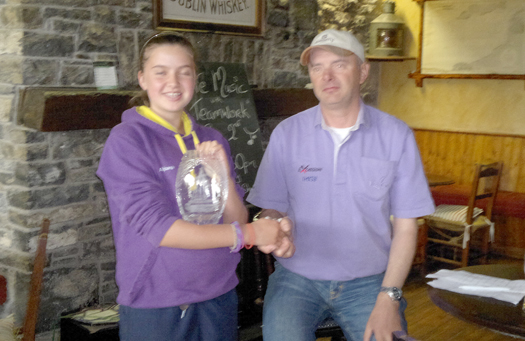
Crew member of Alpara, Mary McCormack receives the Sean Keating trophy
Unfortunately, skippers had to contend with light south-westerly winds, which took the vessels that bit longer to reach their destination.
The trophies that were raced for were the Galleon Cup and the Sean Keating trophy.
The yacht Battle were victorious on corrected time to win the Galleon Cup; second was John Conway on Golden Kopper and third, Team Foynes on Dexterity.
For the White Sails division, who were racing for the Sean Keating trophy, James McCormack on Alpara took line honours with closely followed in second by Pat Finucane on Marengo and third, Jessica Leigh.
At the presentation of prizes in the Galleon Inn, sailing captain, Liam Madden thanked all the participants who took part in the first race of the September series.
Racing continues every Sunday for the month with first gun at 2pm. Crews are asked to be at the marina at 1pm.
'Battle' Leads Foynes September Series
The September Series of racing continued at Foynes Yacht Club last Sunday, where a record entry of craft 'took to the water' in their respective classes.
In class 1 Battle stands as the leader so far, closely followed by Hello and Golden Kopper.
In the white sails division Marengo is heading the group, who is beating stiff competition from the other yachts, and in the Mermaid division, Sea Fox and Argo are also battling for line honours.
The weather conditions were a force 4 to 5 westerly wind, with quite a large swell pertaining for most of the race.
The Officer of the Day, Ray McGibney sent class 1 down to the Loughill buoy and back up the Clare shore to round the Sturamus mark and finish at the clubline.
In a keenly contested race in class 1, Donal McCormack and John-Paul Buckley on Battle, fought off Liam Madden on Hello, who was closely followed by John and Edward Conway on Golden Kopper.
The white sails division raced down to the Loughill mark and back to the club finish line, and this is being led by Pat Finucane on Marengo, who has two wins so far. In second place is Dave Bevan on Mariposa.
In a very exciting race between Mermaid class captain, Conor Roche on Sea Fox and Darragh McCormack on Argo, who were literally 'neck and neck' for all of the race, but in the end the tactical skills of Conor took the better of Darragh at the finish line.
So far, the series has been well supported by all members, who are also vieing for the laurels in their divisions. Racing next Sunday starts at 1pm.
Zuleika Dominates Second Race of Mermaid Week
Yesterday (Monday), Foynes lived up to it's reputation as being a tricky place in which to sail. A strong ebbing tide and shifty 8-10 knot breeze dominated racing in the 33 strong Mermaid fleet in Race 2 of the National Championship.
Race Officer, Liam Dineen, conscious of the effect of the tide sweeping across the start line opted to fly flag I instead of P at 4 minutes before start. This meant that any boats over the line in the last minute, had to go around either end of the start line before starting. The tide swept some boats over, and an individual recall was sounded, but no boats came back to restart.
Five times champion Derek Joyce in 187 Zuleika totally dominated the race, leading all the way and crossing the finish line in first place, to the sound of silence – he scored OCS as he was one of six boats over the line. Shay O'Toole's 182 Dolphin crossed one minute later and scored a first place, with Jim Dempsey in 183 Wannago in third place. Next to cross the line was Ross Galbraith in 185 The Message, but he also scored OCS. Wild Wind 131 (Paddy Dillon) was third, Vee 123 (Jim Carthy) was fourth. Enda Weldon in 186 MyDi crossed next but scored OCS, giving fifth place to Anthony Carthy in 188 Innocence. In the beats today it generally paid to go right, thus getting into the channel and riding the 1.9knot ebbing tide. There was a lot of place swapping on the last beat as the wind shifted NW, punishing those on the lay line.
This now leaves the championship wide open. One discard will apply once five races have been sailed and this leaves Championship contender Joyce with a hill to climb.
Overall placing after two races: 1st 183 Wannago (Dempsey) 4 points, 2nd 123 Vee (J Carthy) 5 points, 3rd 131 Wild Wind (Dillon), 7 points, 4th 188 Innocence (A Carthy) 10 points, 5th 135 Cara II (F Browne) 11 points. Today's winner, 182 Dolphin (S O'Toole) is 6th overall on equal points with 7th place 134 Jill (Smith). The remainder of the top 10 are 177 This is It, 73 Lively Lady and 77 Tiller Girl. Joyce is 18th with 40 points and is waiting for that discard to apply.
In the Daphne fleet (equivalent of Silver fleet), Geraldine O'Neill in 73 Lively Lady leads at 4 points, Paddy Boardman in 26 Thumbalina and Martin O'Toole in 179 Bean Adhmaid are next with 7 points each. In the Designer fleet (equivalent of Bronze), the leader is Mark Boylan in 177 This Is It with two wins, followed by Mark McCormack in 54 Hycilla and Paddy Archer in 18 Clare.
The first Mermaid was built in 1932 and new boats are currently under construction this year. The average age of the thirty three boats racing this week is 42.2 years.
Racing continues today, Tuesday, at 15:00, followed by the Crew Race at approximately 17:30. A Live Commentary is streamed on the web at www.dublinbaymermaid.org/foynes2010 (click on Commentary), and yesterday's commentary was viewed 435 by Mermaiders, retired sailors, family and friends all over the world. Today's Live Commentary will start at 14:30 and will continue till the end of the Crew Race at about 19:15.
Foynes Prepares to Stage Mermaid Week
Foynes Yacht Club on the Shannon Estuary is hosting the National Mermaid Championships, which will commence on Saturday, July 31, and which will be taking place for a full week at Cooleen Point.
Quite an amount of preparation and organisation is taking place to ensure that it will be one of the most successful championships to date.
Entries are expected to exceed 40 boats that will compete in the championship's. These boats are a classic 1932 design from all corners of Ireland, which will be racing daily for seven days on the majestic Shannon Estuary waters to the picturesque and historic port village of Foynes.
The competition brings with it a festival atmosphere, as over 150 sailors with their families and friends settle in for a week packed, competitive and social activities by day and night.
An action-packed programme of events will take place during the championships 'off the water', and this will commence on Saturday, July 31 with Karaoke; on Sunday, August 1 music will be provided by 'Motive'.
On Monday, August 2 a 'Family Fun Day' in Cooleen Point will take place, and this will feature a fundraising family fun, and games in aid of the Royal National Lifeboat Institution.
Besides such activities as a Bouncy Castle, Bar-B-Que, Karaoke and many more events, and the first ever sponsored Mud Splat Obstacle Course race, which will make very entertaining viewing.
And an added spectacle on Monday an air display from the Coastguard Helicopter based in Shannon, Co. Clare will take place.
A quiz night will take place on Tuesday, August 3, and on Wednesday, August 4, a Traditional music session will take place; on Thursday, August 5 a Comedy night is organised.
The Royal National Lifeboat Institution has saved more than 139,000 lives since its foundation in 1824. Through the years, there have been countless stories of courage against a background of technological developments and social change.
The charity was founded as the national institution for the preservation of life from shipwreck after an appeal was made by Sir William Hillary. Hillary lived in Douglas on the Isle of Man, and had witnessed the wrecking of dozens of ships from his home.
The name was changed to the Royal National Lifeboat Institution in 1854, and cork lifejackets were first issued to crew members in the same year.
In 1891, the first RNLI street collection was held in Manchester, and the 20th century saw the RNLI continue to save lives through two world wars.
The lifeboats moved from sail and oar power to petrol and diesel, and the first women joined their crews.
Recent years have seen major develpments with the introduction of RNLI lifeguards in 2001, and the first lifeboat station on an inland water in the same year.
There are 43 RNLI lifeboat stations in Ireland, where the nearest to Foynes is in Kilrush. The money raised from Mermaid week for the RNLI will be put to good use by RNLI personnel, where it will fund new equipment including lifeboats, seafaring wear, lifejackets and much more.
Foynes Yacht Club, Commodore Tom Murray is making a special appeal to all Mermaid sailors, club members and friends to come to the club and support this very worthy cause. 'The RNLI relies on the support of all the sailing and yacht clubs in the country for donations to keep this very important sea rescue operation running', he said.
Crew and assistance for crash boats will be wanted for the championships, so any member, who is interested in sailing or would like to help in the running of the championships are asked to please contact Commodore Tom Murray on 087 2563515; Mermaid Class Captain, Conor Roche on 086 8030343 or Cruiser Class Captain, Alan McEneff on 086 2568280 immediately.
The club website is www.foynesyachtclub.com
Foynes Yacht Club Regatta Takes Place on Sunday
This Sunday, July 11 at Foynes Yacht Club the annual regatta will take place. It is expected that all craft and members will be sailing for what promises to be an eventual day. Class 1, 2, White Sails, Mermaids and the Topaz fleets will be competeing for the trophies in their respective classes, proceedings will begin at 2.30pm.
Foynes YC had the biggest number of entries with six boats, who did extremely well in the West of Ireland Offshore Racing Championships, which were hosted by the Royal Western Yacht Club, Kilrush from Wednesday of last week to Saturday.
Unfortunately, no racing on Friday took place due to the extreme wind conditions, but Officer of the Day, Alan Crosbie, and his team did excellent work in getting six races completed for each of the four classes.
Strong winds prevailed for all the races so reduced sail area and lively conditions afloat made for exciting sailing.
On Saturday last, race starts and management for thre last two races was conducted from the Naval vessel, LE Aoife making a visit to Kilrush for a Sea festival weekend hosted by Kilrush Chamber of Commerce.
The six entrants from Foynes Yacht Club had their most successful west coast championships for years with Dis-a-ray sailing in Class 2 owned by Ray McGibney from Tarbert declared the overall champion when all the results had been tallied.
As well as Dis-a-ray picking up the WIORA cup silverware. Dexterity also won the X332 Raymarine Cup for being the best placed X-yachts boat at the championships.
Overall class results and finishing positions for all six Foynes boats who completed as follows: Class 1 IRC, 4th Dexterity, Team Foynes. Class 1 Echo, 2nd Dexterity, Team Foynes.
Class 2 IRC, 1st Dis-a-ray, Ray McGibney. Class 2, IRC, 5th, Golden Kopper, John and Edward Conway. Class 2, Echo, 4th Dis-a-ray, Ray McGibney. Class 2, Echo, 6th Golden Kopper, John and Edward Conway.
Class 3, IRC, 2nd Battle, Donal McCormack and John-Paul Buckley. Class 3, Echo 1st Battle, Donal McCormack and John-Paul Buckley.
White Sails: 3rd Jasmine II, John Finnegan. 5th Tangalooma, Des Carswell.
Incidentally, Foynes Yacht Club will be hosting WIORA in July 2012.
Mermaid racing took place last Wednesday evening, where marks were laid in the harbour area. Geoff McDonnell, the seafaring expert came in first with Kilmoon, followed by Mermaid class captain, Conor Roche on Sea Fox, and third was the intrepid sailor, Michael Burke on Seagoon.
Padraic Kelly, sailing 'Mweeloon' set off for France last Saturday morning from the pontoons with his crew of his wife, Annemarie, Brian O'Donnell and John Considine. We wish Padraic and company fair sailing!
Sailing continues every Wednesday for all classes with first gun at 19.25hrs.






























